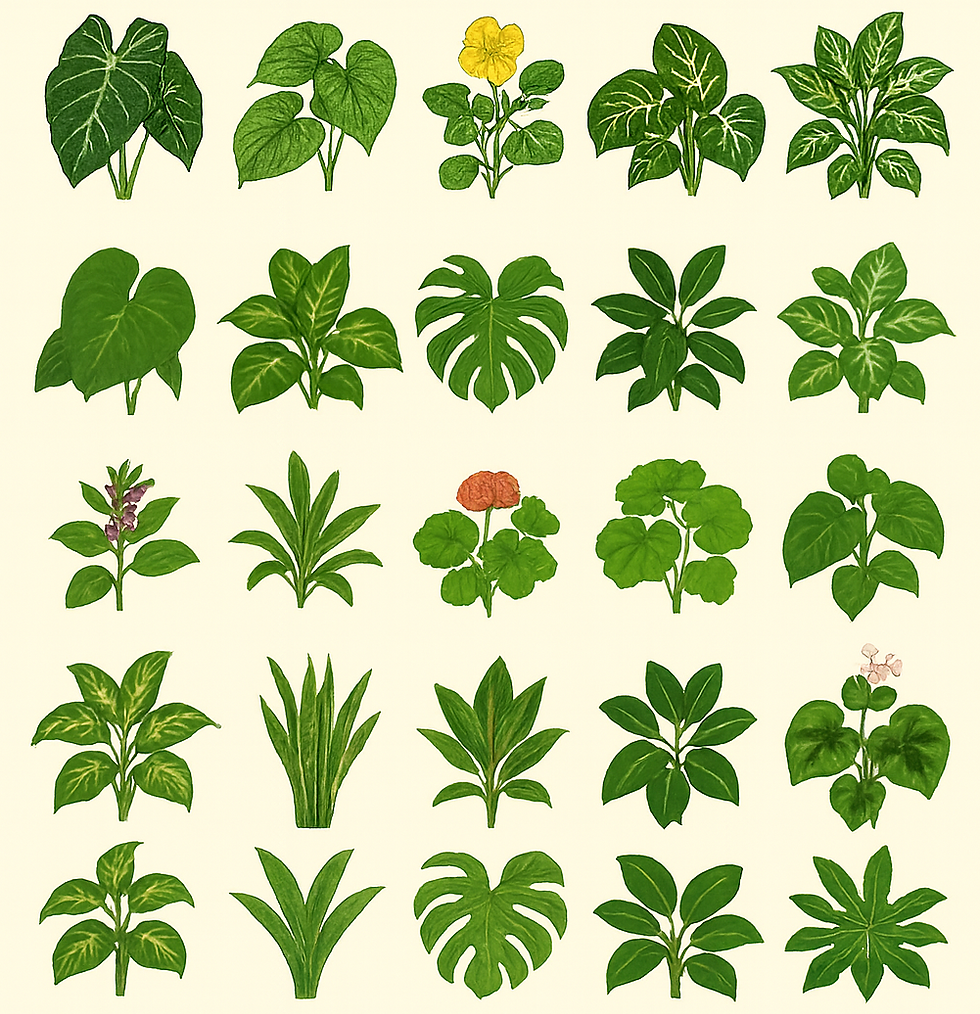25 Common Houseplants That Are Toxic to Dogs
- PetPlantSafety.com
- Aug 14
- 3 min read
Updated: Aug 14

Dogs and houseplants don’t always mix — and while greenery can brighten your home, some plants can be dangerous (or even deadly) for your furry friend. Plant toxicity in dogs can cause symptoms ranging from mild stomach upset to severe organ damage, depending on the species and the amount ingested.
Below, we’ve compiled 25 common houseplants that are toxic to dogs. Each listing links to a detailed page with toxicity level, symptoms, and safer alternatives.
Houseplants Toxic to Dogs
Toxicity Level: Mild
Why Dangerous: Contains insoluble calcium oxalates, which cause mouth irritation and drooling.
Alternatives: Calathea / Rattlesnake plant (Calathea insignis); Prayer plant (Maranta leuconeura); Cast iron plant (Aspidistra elatior)
Toxicity Level: Mild
Why Dangerous: Soluble calcium oxalates cause oral irritation and difficulty swallowing.
Alternatives: African violet (Saintpaulia); Polka dot plant (Hypoestes); Nerve plant (Fittonia)
Toxicity Level: Mild
Why Dangerous: Protoanemonin can cause mouth blisters and digestive distress.
Alternatives: Roses (Rosa spp.); Snapdragons (Antirrhinum); Zinnias
Toxicity Level: Mild
Why Dangerous: Calcium oxalates cause severe mouth irritation.
Alternatives: Wax plant (Hoya carnosa/kerrii); Baby rubber plant (Peperomia obtusifolia); Chinese money plant (Pilea peperomioides)
Toxicity Level: Moderate
Why Dangerous: Oxalates cause painful swelling in mouth and throat.
Alternatives: Parlor palm (Chamaedorea elegans); Cast iron plant (Aspidistra); Calathea
Toxicity Level: High
Why Dangerous: Can cause oral irritation, vomiting, and difficulty breathing.
Alternatives: Hoya; Peperomia obtusifolia; Spider plant (Chlorophytum)
Toxicity Level: High
Why Dangerous: Insoluble oxalates irritate mouth, tongue, and lips.
Alternatives: Calathea; Hoya; Pilea peperomioides
Toxicity Level: Moderate
Why Dangerous: Chewing releases crystals that inflame mouth and airways.
Alternatives: Parlor palm (Chamaedorea elegans); Cast iron plant (Aspidistra); Calathea
Toxicity Level: Moderate
Why Dangerous: Same hazards as Dieffenbachia; duplicate names in trade.
Alternatives: Parlor palm (Chamaedorea elegans); Cast iron plant (Aspidistra); Calathea
Toxicity Level: Mild
Why Dangerous: Calcium oxalates cause drooling and loss of appetite.
Alternatives: African violet (Saintpaulia); Polka dot plant (Hypoestes); Nerve plant (Fittonia)
Toxicity Level: Moderate
Why Dangerous: Same as other Dieffenbachia cultivars.
Alternatives: Parlor palm (Chamaedorea elegans); Cast iron plant (Aspidistra); Calathea
Toxicity Level: High
Why Dangerous: Severe oral irritation and swelling.
Alternatives: Hoya; Peperomia obtusifolia; Spider plant (Chlorophytum)
Toxicity Level: Mild
Why Dangerous: Can cause vomiting and skin irritation.
Alternatives: Baby rubber plant (Peperomia obtusifolia); Parlor palm; Areca palm (Dypsis lutescens)
Toxicity Level: Mild
Why Dangerous: Protoanemonin causes drooling and lethargy.
Alternatives: Roses (Rosa spp.); Snapdragons (Antirrhinum); Zinnias
Toxicity Level: Mild
Why Dangerous: Saponins can cause vomiting and dilated pupils.
Alternatives: Polka dot plant (Hypoestes); Cast iron plant; Parlor palm
Toxicity Level: Mild
Why Dangerous: Linalool and geraniol can irritate skin and stomach.
Alternatives: Petunias; Snapdragons; Camellia
Toxicity Level: Moderate
Why Dangerous: Causes intense mouth pain and swelling.
Alternatives: Parlor palm (Chamaedorea elegans); Cast iron plant (Aspidistra); Calathea
Toxicity Level: Moderate
Why Dangerous: Same risks as other Dieffenbachia.
Alternatives: Parlor palm (Chamaedorea elegans); Cast iron plant (Aspidistra); Calathea
Toxicity Level: Mild
Why Dangerous: Can cause vomiting and loss of appetite.
Alternatives: Polka dot plant (Hypoestes); Cast iron plant; Parlor palm
Toxicity Level: Mild
Why Dangerous: Saponins irritate digestive system.
Alternatives: Haworthia (incl. Zebra Haworthia); Echeveria; Cast iron plant
Toxicity Level: Mild
Why Dangerous: Saponins cause vomiting and disorientation.
Alternatives: Parlor palm; Areca palm; Bromeliads (Guzmania/Neoregalia)
Toxicity Level: High
Why Dangerous: Can cause severe swelling and breathing problems.
Alternatives: Hoya; Peperomia obtusifolia; Spider plant (Chlorophytum)
Toxicity Level: Mild
Why Dangerous: Irritates mouth and digestive tract.
Alternatives: Calathea; Hoya; Pilea peperomioides
Toxicity Level: Mild
Why Dangerous: May cause skin rash and digestive upset.
Alternatives: Baby rubber plant (Peperomia obtusifolia); Parlor palm
Toxicity Level: Mild
Why Dangerous: Calcium oxalates cause drooling and difficulty eating.
Alternatives: African violet (Saintpaulia); Polka dot plant (Hypoestes); Nerve plant (Fittonia)
What to Do if Your Dog Eats One of These Plants
If you suspect your dog has chewed on or ingested any of these plants:
Remove any remaining plant matter from their mouth.
Rinse their mouth gently with water.
Contact your veterinarian immediately or call the ASPCA Animal Poison Control Center at 888-426-4435.
Do not induce vomiting unless instructed by a vet.
Disclaimer: This content is for informational purposes only and is not a substitute for professional veterinary advice. Always seek the advice of your veterinarian with any questions about your pet’s health.


Comments